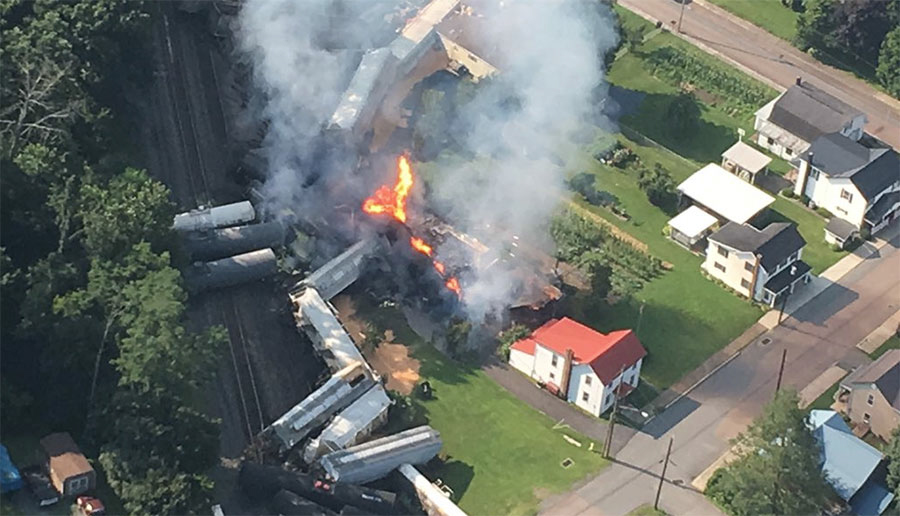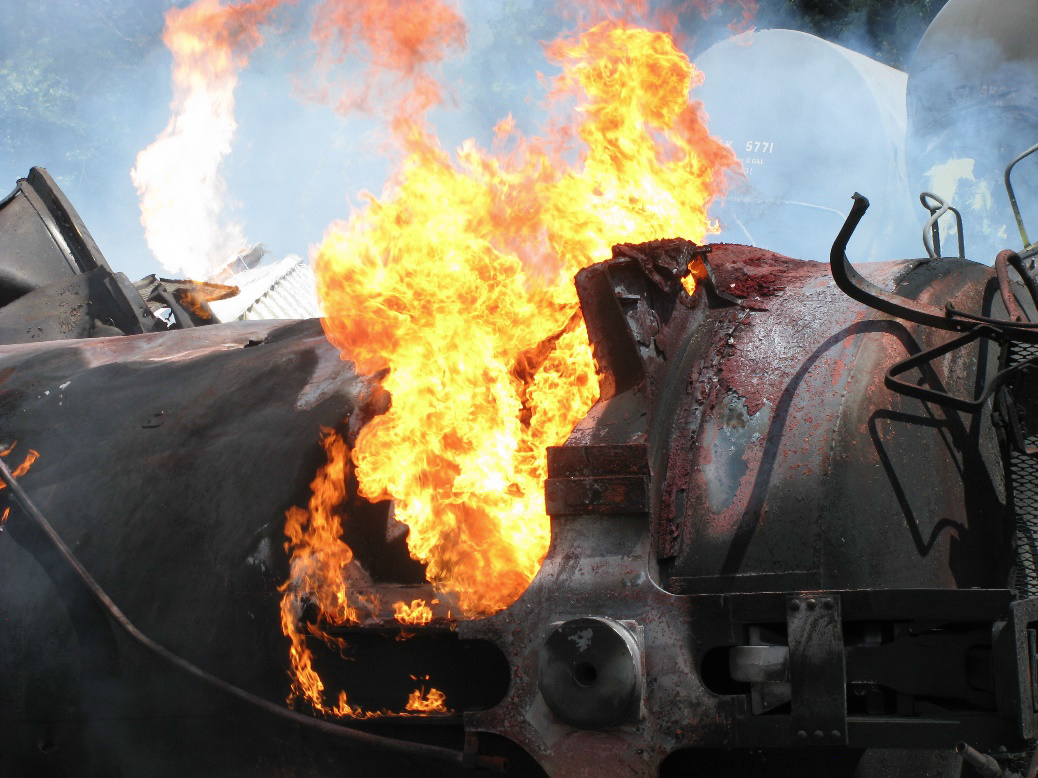August 22nd, 2017 by WCBC Radio
The following report was released Monday by the National Transportation Safety Board:
On August 2, 2017, about 4:54 a.m. eastern daylight time, CSX Transportation (CSX) train Q38831, with 5 locomotives and 178 railcars (128 loaded and 50 empty), derailed railcars 33 through 65 in Hyndman Borough, Bedford County, Pennsylvania. Three hazardous material tank cars were breached and released material: one containing propane, one containing asphalt, and one containing molten sulfur. Both the propane tank car and the molten sulfur tank released caught fire. (See figure 1.) About 1,000 residents within a 1-mile radius were evacuated and several highway-railroad grade crossings were closed. There were no injuries or fatalities. On August 5, about 12:00 p.m., the evacuation was lifted. At the time of the accident, the sky was clear, visibility was 10 miles, and the temperature was 64°F.

NTSB Report: Hyndman Derailment courtesy Pennsylvania State Police
Two train crews were involved in the movement of the train before the accident. The first crew stopped the train on a descending grade after encountering air brake problems. The crew applied 58 hand brakes while inspecting and recharging the air brake system. The conductor of this first crew found an air leak on a railcar about 20 railcars from the rear of the train. A CSX mechanical employee arrived to repair the air leak. However, by the time this issue was resolved, the crew did not have enough remaining duty time to complete the trip. Therefore, CSX relieved them with a new train crew.
The second crew, thinking the train may still have air brake problems, kept all 58 hand brakes applied and unsuccessfully tried to pull the train down the hill. The conductor of the second crew then released the first 25 hand brakes, leaving 33 hand brakes still applied. The engineer applied a minimum air brake application and started the train with locomotive power down the grade. The train speed varied from 20 to 30 mph. The engineer switched from locomotive power to dynamic braking three times before the train derailed.
National Transportation Safety Board (NTSB) investigators determined that the 35th railcar derailed one set of wheels on a curve 1.7 miles before the location of the general derailment and fire. When the derailed railcar reached a highway-railroad grade crossing, the railcar moved further off the rail, initiating the derailment of the other railcars. NTSB investigators discovered that several railcar wheels east and west of the derailed cars had flat spots and built-up tread from the hand brakes not allowing the wheels to rotate, and bluing due to brake pad friction.
The weight of the train from the 1st railcar in the consist to the 35th, was about 1,631 tons. The weight of the remaining 143 railcars trailing the 35th railcar was about 16,621 tons. The 35th railcar from the front of the train was an empty high-sided gondola within a block of 27 empty railcars. NTSB is investigating many factors into the cause of the derailment, including the length, make-up, and operation of the train, as well as the condition of the railcars and track.
Fifteen tank cars transporting hazardous materials were involved in the derailment, including three tank cars containing propane, eight tank cars containing molten sulfur, two tank cars containing asphalt, and two tank cars containing phosphoric acid residue.
The 46th car from the front of the train, a 23,467-gallon specification US Department of Transportation (DOT)-111 general service tank car, released its load of elevated temperature asphalt from a bottom outlet valve that opened during the derailment sequence.[1] The released asphalt pooled and solidified near the railcar pileup. The 49th railcar from the front of the train, a 13,880-gallon specification DOT-111 general service tank car, released its load of molten sulfur from two tank shell tears. The released molten sulfur ignited and burned for more than 48 hours.
The 53rd car, a 33,710-gallon specification DOT-112 pressure tank car, released its load of odorized propane from a punctured tank shell.[2] The puncture measured about 3 1/4-inch in length and about 1/4-inch wide. Released propane gas escaped through the void space between the jacket and tank shell and emerged burning vigorously at several locations on the tank car for more than 48 hours. A 6-inch-high bulge, measuring 27 inches longitudinally and 56 inches circumferentially, formed in the tank shell above the body bolster near one point of fire exposure (See figure 2).

NTSB Report: Hyndman Derailment Tanker Car On Fire, Courtesy CSX
Portions of the propane tank car were removed and shipped to the NTSB Materials Laboratory for examination.
Parties to the investigation are the Federal Railroad Administration, CSX Transportation, the Brotherhood of Locomotive Engineers and Trainmen, the International Association of Sheet Metal, Air, Rail and Transportation Workers, and the Pennsylvania Public Utilities Commission.
1 General service tank cars typically transport a wide variety of liquid and solid hazardous materials, as well as nonregulated commodities.
2 Pressure tank cars are stronger than general service tank cars because their thicker tanks allow them to withstand higher internal pressures. These tank cars typically transport liquefied compressed gases, poison/toxic inhalation hazard materials, reactive materials, and some corrosive materials.
Probable Cause




.jpg)













